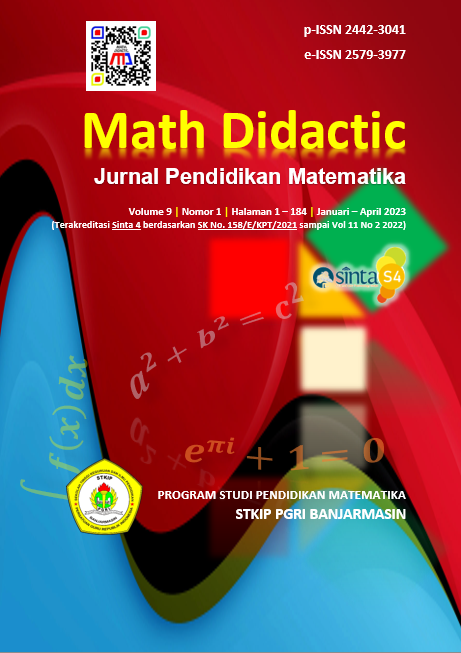The effect of geogebra-assisted STEM learning on the creative thinking student of SMK Negeri 1 Lebong
Pengaruh pembelajaran STEM berbantuan GeoGebra terhadap kemampuan berpikir kreatif siswa SMK Negeri 1 Lebong
Abstrak
The purpose of the study was to determine the effect of the GeoGebra-assisted STEM (Science, Technology, Engineering, and Mathematics) approach to linear curriculum material on the creative thinking of SMK Negeri 1 Lebong students. The study used quantitative with quasi-experimental research. Data collection methods are done using inductive data aggregation and analysis The measures used were pre-test and post-test The subjects consisted of the experimental class, i.e., Class X Multimedia 1 and Trial Class i.e., Class X 2. Based on the results of data analysis and discussion, it can be concluded that the result of students' creative thinking skills for the primary test (preliminary test) in the experimental class was in the low category with a mean score of 54.68, and in addition, the control class was in the low category with a score of 52.80 average, and the post-test result (final test) in the experimental class was in the average category with a mean score of 86.36, while the control class was high. the average score was 74.9. From the average, it can be seen that the STEM method with the help of Geogebra linear curriculum material influences the creative thinking of the students of SMK Negeri 1 Lebong.
##plugins.generic.usageStats.downloads##
Referensi
Amelia, A. (2019). Penerapan Model Pembelajaran Problem Based Learning Berbasis STEM (Science, Technology, Engineering and Mathematics) untuk Meningkatkan Kemampuan Pemecahan Masalah Matematika Materi Program Linear Siswa Kelas XI IPA MA Nasruddin Dampit TA 2018/2019. Jurnal Penelitian, Pendidikan, Dan Pembelajaran, 14(02).
Arikunto, S. (2021). Prosedur Penelitian.
Budiarto, E., Tampubolon, B., & Uliyanti, E. (2016). Pengaruh penggunaan Model Kooperatif Teknik Numbered Heads Together terhadap Hasil Belajar Siswa pada Pembelajaran Matematika di Kelas III SD Negeri 29 Pontianak Kota.
Cahyono, T. (2015). Statistik Uji Normalitas (1st ed.). YASAMAS.
Daugherty, M. K. (2013). The Prospect of an “A” in STEM Education. In Journal of STEM Education.
Hastjarjo, T. D. (2019). Rancangan Eksperimen Quasi. Buletin Psikologi, 27(2), 187–203.
Magdalena, T., & Surya, E. (2017). Pengaruh Model Pembelajaran Means-Ends Analysis terhadap Kemampuan Pemecahan Masalah Matematika Siswa pada Materi SPLDV pada Kelas X SMA. https://www.researchgate.net/publication/321831951
Malik, A., & Chusni, M. (2018). Pengantar Statistika Pendidikan (1st ed.). Deepublish.
Nurfitriyanti, M. (2016). Model Pembelajaran Project Based Learning terhadap Kemampuan Pemecahan Masalah Matematika. Jurnal Formatif, 6(2), 149–160.
Nuryadi, Astuti, T. D., Utami, E. S., & Budiantara, M. (2017). Dasar-dasar Statistik Penelitian (1st ed.). SIBUKU MEDIA.
Pujianti, B. D. (2016). Efektivitas Pemberian Pretest dan Posttest dalam Meningkatkan Prestasi Belajar Fisika siswa. IKIPMU Maumere.
Rahayu, P. (2021). Pengaruh Pembelajaran STEM (Sains, Teknologi, Teknik, dan Matematika) Berbantuan Google Classroom terhadap Keterampilan Berpikir Kritis dan Minat Belajar Fisika Siswa SMA Negeri 2 Menggala.
Rahman, A. A. (2018). Strategi Belajar Mengajar Matematika (1st ed.). Syiah Kuala University Press.
Ramdani, Y. (2014). Pembelajaran dengan Scientific Debate untuk meningkatkan kemampuan berpikir kreatif mahasiswa. MIMBAR, 30(1), 1–10.
Risdianto, E. (2019). Analisis Pendidikan Indonesia di Era Revolusi Industri 4.0. ResearchGate.
Rukminingsih, Adnan, G., & Latief, M. A. (2020). Metode Penelitian Pendidikan Penelitian Kuantitatif, Penelitian Kualitatif, Penelitian Tindakan Kelas (E. Munastiwi & H. Ardi, Eds.; 1st ed.). Erhaka Utama. www.erhakautama.com
Sundayana, R. (2016). Kaitan antara Gaya Belajar, Kemandirian Belajar, dan Kemampuan Pemecahan Masalah Siswa SMP dalam Pelajaran Matematika. Jurnal Pendidikan Matematika, , 5(2), 4280. http://e-mosharafa.org/Jurnal"
Tandiseru, S. (2015). The Effectiveness of Local Culture-Based Mathematical Heuristic-KR Learning towards Enhancing Student’s Creative Thinking Skill. 6(12). www.iiste.org
Widana, I. W., & Muliani, P. (2020). Uji Persyaratan Analisis (T. Fiktorius, Ed.). KLIK MEDIA.
Yani, A., Asri, A. F., & Burhan, A. (2014). Analisis Tingkat Kesukaran, Daya Pembeda Dan Fungsi Distraktor Soal Ujian Semester Ganjil Mata Pelajaran Produktif di SMK Negeri 1 Indralaya Utara Tahun Pelajaran 2012/2013. Ejournal UNSRI, 98–115.






















